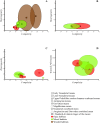Neandertal versus Modern Human Dietary Responses to Climatic Fluctuations
- PMID: 27119336
- PMCID: PMC4847867
- DOI: 10.1371/journal.pone.0153277
Neandertal versus Modern Human Dietary Responses to Climatic Fluctuations
Abstract
The Neandertal lineage developed successfully throughout western Eurasia and effectively survived the harsh and severely changing environments of the alternating glacial/interglacial cycles from the middle of the Pleistocene until Marine Isotope Stage 3. Yet, towards the end of this stage, at the time of deteriorating climatic conditions that eventually led to the Last Glacial Maximum, and soon after modern humans entered western Eurasia, the Neandertals disappeared. Western Eurasia was by then exclusively occupied by modern humans. We use occlusal molar microwear texture analysis to examine aspects of diet in western Eurasian Paleolithic hominins in relation to fluctuations in food supplies that resulted from the oscillating climatic conditions of the Pleistocene. There is demonstrable evidence for differences in behavior that distinguish Upper Paleolithic humans from members of the Neandertal lineage. Specifically, whereas the Neandertals altered their diets in response to changing paleoecological conditions, the diets of Upper Paleolithic humans seem to have been less affected by slight changes in vegetation/climatic conditions but were linked to changes in their technological complexes. The results of this study also indicate differences in resource exploitation strategies between these two hominin groups. We argue that these differences in subsistence strategies, if they had already been established at the time of the first contact between these two hominin taxa, may have given modern humans an advantage over the Neandertals, and may have contributed to the persistence of our species despite habitat-related changes in food availabilities associated with climate fluctuations.
Conflict of interest statement
Figures

Similar articles
-
Ecogeographic variation in Neandertal dietary habits: evidence from occlusal molar microwear texture analysis.J Hum Evol. 2011 Oct;61(4):411-24. doi: 10.1016/j.jhevol.2011.05.004. Epub 2011 Jun 29. J Hum Evol. 2011. PMID: 21719068
-
Diet of upper paleolithic modern humans: evidence from microwear texture analysis.Am J Phys Anthropol. 2014 Apr;153(4):570-81. doi: 10.1002/ajpa.22457. Epub 2014 Jan 21. Am J Phys Anthropol. 2014. PMID: 24449141
-
Non-occlusal dental microwear variability in a sample of Middle and Late Pleistocene human populations from Europe and the Near East.J Hum Evol. 2003 Apr;44(4):497-513. doi: 10.1016/s0047-2484(03)00030-7. J Hum Evol. 2003. PMID: 12727465
-
Hunters of the Ice Age: The biology of Upper Paleolithic people.Am J Phys Anthropol. 2008;Suppl 47:70-99. doi: 10.1002/ajpa.20950. Am J Phys Anthropol. 2008. PMID: 19003886 Review.
-
Possible paleohydrologic and paleoclimatic effects on hominin migration and occupation of the Levantine Middle Paleolithic.J Hum Evol. 2011 Apr;60(4):437-51. doi: 10.1016/j.jhevol.2010.03.010. Epub 2010 Jun 11. J Hum Evol. 2011. PMID: 20541789 Review.
Cited by
-
Analyzing blank cutting edge efficiency associated with the adoption of microblade technology: A case study from Tolbor-17, Mongolia.PLoS One. 2024 Aug 16;19(8):e0305136. doi: 10.1371/journal.pone.0305136. eCollection 2024. PLoS One. 2024. PMID: 39150911 Free PMC article.
-
Differences in childhood stress between Neanderthals and early modern humans as reflected by dental enamel growth disruptions.Sci Rep. 2024 May 23;14(1):11293. doi: 10.1038/s41598-024-61321-x. Sci Rep. 2024. PMID: 38782948 Free PMC article.
-
A Catalog of Coding Sequence Variations in Salivary Proteins' Genes Occurring during Recent Human Evolution.Int J Mol Sci. 2023 Oct 9;24(19):15010. doi: 10.3390/ijms241915010. Int J Mol Sci. 2023. PMID: 37834461 Free PMC article.
-
Changing perspectives on early hominin diets.Proc Natl Acad Sci U S A. 2023 Feb 14;120(7):e2201421120. doi: 10.1073/pnas.2201421120. Epub 2023 Feb 6. Proc Natl Acad Sci U S A. 2023. PMID: 36745809 Free PMC article.
-
A Major Change in Rate of Climate Niche Envelope Evolution during Hominid History.iScience. 2020 Oct 15;23(11):101693. doi: 10.1016/j.isci.2020.101693. eCollection 2020 Nov 20. iScience. 2020. PMID: 33163945 Free PMC article.
References
-
- van Andel T, Tzedakis PC. Paleolithic landscapes of Europe and environs 150,000–25,000 years ago: an overview. Quat Sci Rev. 1996;15: 481–500.
-
- Dansgaard W, Johnsen SJ, Clausen HB, Dahl-Jensen D, Gundestrup NS, Hammer CU, et al. Evidence for general instability of past climate from a 250 kyr ice core record. Nature. 1993;364: 218–220.
-
- Hublin J-J. The modern human colonization of western Eurasia: when and where? Quat Sci Rev. 2015;118: 194–210.
Publication types
MeSH terms
Grants and funding
LinkOut - more resources
Full Text Sources
Other Literature Sources


